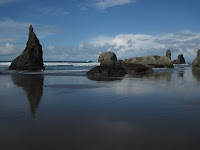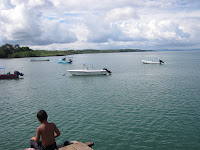Each of my six rainy season field sites on the Rio Pacuare is
different and each day’s weather differs from the forecast predictions of the
night before -- ranging from deluge to clear and sunny.
Field work in the tropics
is an incredible lesson in flexibility, evaluation, and decision making.
Then ... how might one go about measuring, counting,
and surveying all of these rocks and the raging river that delivers them?
 |
| Tres Equis site boulder bar |
 |
| setting control points in bedrock - Mollejones canyon site |
 |
| Good condition section of an access road |
Access to all sites is on 4x4 single track dirt roads of
varying condition that twist and drop or climb through the jungle or next to
partially cleared small scale fincas of sugar cane or cattle and often through
creeks that swell quickly with rains. So
far my 1988 Samari 4x4 (I have named Mula) has putted through the bumber-high mud
and crawled over steep rocky grades. Sometimes
the road turns into more of a foot path deeply pocked with the prints of horses
that are used by the farmers or the indigenous Cabecar that traverse these bi-ways
from their lands within the reserves along the Pacuare and Chirripo. At those
points the field gear goes into our packs and we walk the remaining meters or
miles to the sites.
With the help of my great field assistant Octavio as of
Friday I have set up 6 field sites for rainy season data collection. Now I wait for some serious rain that will
make the river rise over the boulders ,,,, and then we will return to measure
the changes at each site.

On Friday we were at a site in the upper sections of the
river. We parked at the end of a small
steep spur road next to a trail that leads to a foot bridge over the river and
into the indigenous reserve. On the
other side of the river we walked downstream a bit to my most upstream rainy
season field site. A mix of rain and sun
throughout the day led to quickly shifting clouds that sometimes clung to steep
surrounding mountains thickly vegetated with jungle. In the late afternoon two Cabecar
fishermen walked up the river casting their nets into the current. The river is strong here but they moved slowly
upstream with each cast - dangerous. Their
lives are tranquil but hard, and dependent on this river that transects their
lands.
 |
| Cabecar fisherman casting his net in the Rio Pacuare near Paso Marcos -- Dec 28, 2012 |
Some have asked ….. so here are a few sentences about my
research and why I am in Costa Rica working on the Rio Pacuare: I am interested
in the sediment transport of bedload material (gravels to large boulders) in
tropical mountain rivers and how this relates to channel form and system
connectivity in such dynamic systems. I
am also interested in how the bedload transport/geomorphology will be affected
by changes in discharge related to dam construction and/or climate change –
both very real threats. Thus, my field sites are depositional areas (boulder
bars) within the active channel (area that is flooded frequently) in the
geomorphic reaches (characteristically different sections) of the mountainous
Rio Pacuare.
 |
| I dig my office! |
If anyone is interested in
the details of my doctoral research drop me an email and I’ll send you the proposal.
The holiday season in Costa Rica is full of festivals. And though field work has limited my participation
in a lot of the activities, I have joined in here and there with my Costa Rican
family. Making,
sharing, and eating tamales is a big holiday tradition here. And lucky me, the women in my CR family make
some of the best tasting tamales in Costa Rica – and I was able to help
out. We ended up ~75-80 of them.
 |
| Angela and Geri and me -- making tamales |
 |
| In CR tamales are wrapped in banana
leaves and then cooked in water in big pots -- most commonly over an outside fire. In
the days leading up to Christmas the smell of wood smoke and cooking tamales
permeated the country side. |
Winter Solstice – my favorite day of the year! was shared
with friends in Pavones on the other side of Turrialba valley.
A hike up the highest hill in Pavones with
Kurt and his dogs for a vanilla sky sunset over the mountains marked the close
of the solar year.
We returned to make
and enjoy dinner with his family just as the clouds closed in and rain washed
everything clean once again.
On Christmas eve I worked a 10 hour field day on the
beautiful Rio Pacuare, returned home and made an apple pie in time for the
family dinner. Customarily the formal
Christmas eve dinner is late and festive – we had dinner at 9:00pm. This was followed by gifts, treats, and
silliness. And though I am not an
obligatory gift giver on Christmas I did enjoy being included in the
festivities. It was especially fun to
watch the three kids handing out the gifts to everyone and getting so excited
about the gifts they received. When I
went to bed at 11:45 that night the party was still going strong.
My Costa Rican family is so incredibly kind
and good. I am grateful.
A few days ago I went on an early morning run on the dirt
road that winds through the coffee and banana plantations below my apartment. On my way back down the hill that I had just
ran up minutes before, I saw a 1.5 meter long coral snake crossing the road
slowly. It was calm and made no never
mind of me in its casual crossing into the vegetation on the other side of the
road. These are incredibly colorful and venomous
(deathly) snakes but they are also non-aggressive if you don’t bother them. I was able to get a look at it from just a
couple of feet away --- so beautiful! Wish I had had my camera – but here’s an
image from the internet.
Ready for the new calendar year to begin!
 |
| December full moon from my apartment |




























